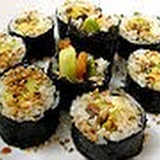
The traditional form of sushi is fermented fish and rice,preserved with salt in a process that has been traced to Southeast Asia,where it remains popular today.The term sushi comes from an archaic grammatical form no longer used in other contexts;literally,"sushi" means "it's sour",a reflection of its historic fermented roots.
The science behind the fermentation of fish packed in rice is that the vinegar produced from fermenting rice breaks the fish down into aminoacids.This results is one of the five basic tastes,called umami in Japanese.The oldest form of sushi in Japan,Narezushi still very closely resembles this process.In Japan,Narezushi involved into Oshizushi and ultimately Edomae nigirizushi,which is what the world today know as "sushi".
Contemporary Japanese sushi has little resemblance to the traditional lacto-fermented rice dish.
Originally,when the fermented fish was taken out of the rice,only the fish was consumed and the fermented rice was discarded.The strong-tasting and-smelling funazushi,a kind of narezushi made near Lake Biwa in Japan,resembles the traditional fermented fish.
Beginning in the Muromachi period (AD 1336-1573) of Japan,vinegar was added to the mixture for better taste and preservation.The vinegar accentuated the rice's sourness and was known to increase its life span,allowing the fermentation process to be shortened and eventually abandoned.
In the following centuries,sushi in Osaka involved into oshi-zushi.The seafood and rice were pressed using wooden(usually bamboo)molds.By the 18th century,this form of sushi had reached Edo (contemporary Tokyo).
The contemporary version,internationally known as "sushi",was invented by Hanaya Yohei (1799 - 1858) at the end of Edo period in Edo.The sushi invented by Hanaya was an early form of fast food that was not fermented (therefore prepared quickly) and could be eaten with one's hands roadside or in a theater.Originally,this sushi was known as Edomae zushi,because it used freshly caught fish in the Edo-mae (Edo Bay or Tokyo Bay).Though the fish used in modern sushi no longer usually comes from Tokyo Bay,it is still formally known as Edomae nigirizushi.











